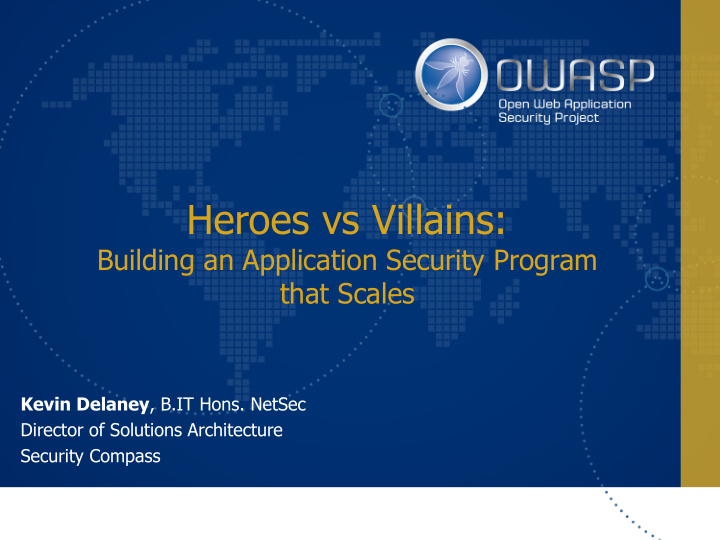



Heroes vs Villains: Building an Application Security Program that Scales Kevin Delaney , B.IT Hons. NetSec Director of Solutions Architecture Security Compass
Over 160 Million Credit Cards lifted over 7 years
Villains are PROACTIVE Heroes are REACTIVE
5 Step Process
Why does this happen? Inexperienced developers • Apathy towards secure development • Overwhelming requirements documents • Too much reliance on static and dynamic analysis • tools
Obstacles
Time, Skills, Security Talent Pin-pointing vulnerabilities Customer requirements and ever before cyber criminals do changing compliance standards The Struggle is Real.
Good help is hard to find Your company is not the only one that struggles to find the experienced IT professionals and security architects necessary to perform risk assessments • 70% of respondents believe their organization does not have enough IT Security Staff • 36% of security positions were unfilled. • 58% of senior security positions were unfilled. .
Shallow Talent Pool Understaffed and at Risk: Today’s IT Security Department - Ponemon Institute
The Numbers Demand for InfoSec jobs growing 3.5x faster than other IT jobs, • 12x faster than all jobs. 12,000 InfoSec professionals surveyed believe that talent shortage • weakened their defenses [ISC2] 70% of companies surveyed in the US believe their IT Security • department is understaffed. 50,000 CISSP postings in the US alone, but only 60,000 CISSP’s • worldwide.
An Expensive Endeavor Average Security Architect salary in the United Kingdom is £75,000
Employers want certified domain experts with multiple years of experience in: • Network security governance • Policies • Procedures • Application Security General Security Knowledge is not Enough
Do more with less • Stop relying on just your security team for security • Identify security champions in your development team and empower them. • Incentivize with training and certifications - transferrable skills. • Teach your heroes to think like VILLAINS!
How to develop an application security program • How to reduce production costs, application • vulnerabilities, and delivery delays How to ensure that secure software is accepted • and delivered effectively.
What makes a GREAT AppSec Program?
Adaptable Security Requirements Scaled Security Information Tailored Security Information Security Baseline
Focused • A great appsec program is focused on the strengths of the people participating. • Ideally, security tasks should be generated on-the-fly based on the profile of the application and its associated risks and delivered directly into your developers’ ALM tools like JIRA or TFS. • Ensures nothing is missed and reduces time spent searching for what’s applicable to a project by multitudes.
Task Code
Collaborative • No more “us vs. them” mentality between developers and security. • Developers must take responsibility for security tasks. • You cannot create a security culture – it is created from within the development org.
Recap • Proper management of security requirements early in the SLDC prevents problems before they happen and turns down the noise from static/dynamic analysis tools. • Delivering these requirements directly to developers in the tools they use every day is critical for acceptance. • Leverage and empower your existing resources, because finding new ones is no easy task. • Make sure your AppSec program is adaptable, focused, and collaborative.
Thank You, Villains! Kevin Delaney Director, Solutions Architecture kdelaney@securitycompass.com http://securitycompass.com/
Recommend
More recommend